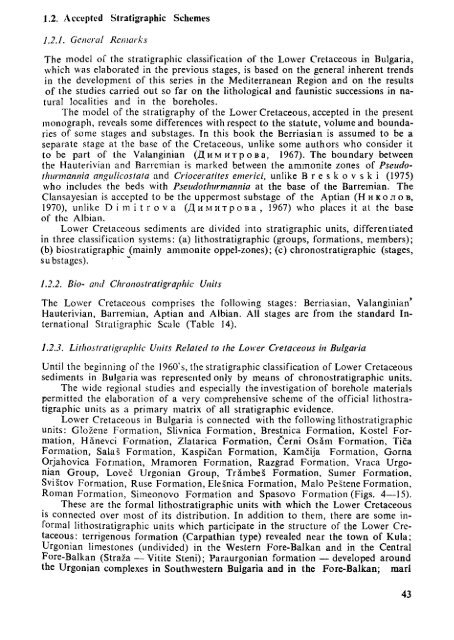THE MEDITERRANEAN LOWER CRETACEOUS
THE MEDITERRANEAN LOWER CRETACEOUS
THE MEDITERRANEAN LOWER CRETACEOUS
Create successful ePaper yourself
Turn your PDF publications into a flip-book with our unique Google optimized e-Paper software.
1.2. Accepted Stratigraphie Schemes<br />
1.2.1. General Remarks<br />
The model of the stratigraphie classification of the Lower Cretaceous in Bulgaria,<br />
which was elaborated in the previous stages, is based on the general inherent trends<br />
in the development of this series in the Mediterranean Region and on the results<br />
of the studies carried out so far on the lithological and faunistic successions in natural<br />
localities and in the boreholes.<br />
The model of the stratigraphy of the Lower Cretaceous, accepted in the present<br />
monograph, reveals some differences with respect to the statute, volume and boundaries<br />
of some stages and substages. Tn this book the Berriasian is assumed to be a<br />
separate stage at the base of the Cretaceous, unlike some authors who consider it<br />
to be part of the Valanginian (Димитрова, 1967). The boundary between<br />
the Hauterivian and Barremian is marked between the ammonite zones of Pseudothurmannia<br />
angulicostata and Crioceratites emerici, unlike Breskovski (1975)<br />
who includes the beds with Pseudothurmannia at the base of the Barremian. The<br />
Clansayesian is accepted to be the uppermost substage of the Aptian (Ни ко л о в,<br />
1970), unlike D i m i t г о v а (Димитрова, 1967) who places it at the base<br />
of the Albian.<br />
Lower Cretaceous sediments are divided into stratigraphie units, differentiated<br />
in three classification systems: (a) lithostratigraphic (groups, formations, members);<br />
(b) biostratigraphic (mainly ammonite oppel-zones); (c) chronostratigraphic (stages,<br />
substages).<br />
1.2.2. Bio- and Chronostratigraphic Units<br />
The Lower Cretaceous comprises the following stages: Berriasian, Valanginian'<br />
Hauterivian, Barremian, Aptian and Albian. All stages are from the standard International<br />
Stratigraphie Scale (Tabic 14).<br />
1.2.3. Lithostratigraphic Units Related to the Lower Cretaceous in Bulgaria<br />
Until the beginning of the 1960's, the stratigraphie classification of Lower Cretaceous<br />
sediments in Bulgaria was represented only by means of chronostratigraphic units.<br />
The wide regional studies and especially the investigation of borehole materials<br />
permitted the elaboration of a very comprehensive scheme of the official lithostratigraphic<br />
units as a primary matrix of all stratigraphie evidence.<br />
Lower Cretaceous in Bulgaria is connected with the following lithostratigraphic<br />
units: Glozene Formation, Slivnica Formation, Brestnica Formation, Kostel Formation,<br />
Hânevci Formation, Zlatarica Formation, Cerni Osâm Formation, Tica<br />
Formation, Salas Formation, Kaspican Formation, Kamcija Formation, Gorna<br />
Orjahovica Formation, Mramoren Formation, Razgrad Formation, Vraca Urgonian<br />
Group, Lovec Urgonian Group, Trambes Formation, Sumer Formation,<br />
Svistov Formation, Ruse Formation, Elesnica Formation, Malo Pestene Formation,<br />
Roman Formation, Simeonovo Formation and Spasovo Formation (Figs. 4—15).<br />
These are the formal lithostratigraphic units with which the Lower Cretaceous<br />
is connected over most of its distribution. In addition to them, there are some informal<br />
lithostratigraphic units which participate in the structure of the Lower Cretaceous:<br />
terrigenous formation (Carpathian type) revealed near the town of Kula;<br />
Urgonian limestones (undivided) in the Western Fore-Balkan and in the Central<br />
Fore-Balkan (Straza — Vitite Steni); Paraurgonian formation — developed around<br />
the Urgonian complexes in Southwestern Bulgaria and in the Fore-Balkan; marl<br />
43

















